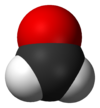Formalin
|
|
|||
 |
|||
| Names | |||
|---|---|---|---|
|
Preferred IUPAC name
Formaldehyde
|
|||
|
Systematic IUPAC name
Methanal
|
|||
| Other names
Methyl aldehyde
Methylene glycol Methylene oxide Formalin (aqueous solution) Formol Carbonyl hydride |
|||
| Identifiers | |||
|
3D model (Jmol)
|
|||
| 3DMet | B00018 | ||
| 1209228 | |||
| ChEBI | |||
| ChemSpider | |||
| DrugBank | |||
| ECHA InfoCard | 100.000.002 | ||
| EC Number | 200-001-8 | ||
| E number | E240 (preservatives) | ||
| 445 | |||
| KEGG | |||
| MeSH | Formaldehyde | ||
|
PubChem CID
|
|||
| RTECS number | LP8925000 | ||
| UNII | |||
| UN number | 2209 | ||
|
|||
|
|||
| Properties | |||
| CH2O | |||
| Molar mass | 30.03 g·mol−1 | ||
| Appearance | Colorless gas | ||
| Density | 0.8153 g/cm3 (−20 °C) | ||
| Melting point | −92 °C (−134 °F; 181 K) | ||
| Boiling point | −19 °C (−2 °F; 254 K) | ||
| 400 g dm−3 | |||
| log P | 0.350 | ||
| Vapor pressure | < 1 atm | ||
| Acidity (pKa) | 13.27 | ||
| -18.6·10−6 cm3/mol | |||
| 2.33 D | |||
| Structure | |||
| C2v | |||
| Trigonal planar | |||
| Pharmacology | |||
| QP53AX19 (WHO) | |||
| Hazards | |||
| Safety data sheet | MSDS | ||
|
EU classification (DSD)
|
Toxic (T) Corrosive (C) Carc. Cat. 1 |
||
| R-phrases | R23/24/25 R34 R43 R45 | ||
| S-phrases | (S1/2) S26 S36/37/39 S45 S51 S53 S60 | ||
| NFPA 704 | |||
| Flash point | 64 °C (147 °F; 337 K) | ||
| 430 °C (806 °F; 703 K) | |||
| Explosive limits | 7–73% | ||
| Lethal dose or concentration (LD, LC): | |||
|
LD50 (median dose)
|
100 mg/kg (oral, rat) | ||
|
LC50 (median concentration)
|
333 ppm (mouse, 2 hr) 815 ppm (rat, 30 min) |
||
|
LCLo (lowest published)
|
333 ppm (cat, 2 hr) | ||
| US health exposure limits (NIOSH): | |||
|
PEL (Permissible)
|
TWA 0.75 ppm ST 2 ppm (as formaldehyde and formalin) | ||
|
REL (Recommended)
|
Ca TWA 0.016 ppm C 0.1 ppm [15-minute] | ||
|
IDLH (Immediate danger)
|
Ca [20 ppm] | ||
| Related compounds | |||
|
Related aldehydes
|
Acetaldehyde Butyraldehyde |
||
|
Related compounds
|
methanol formic acid |
||
|
Except where otherwise noted, data are given for materials in their standard state (at 25 °C [77 °F], 100 kPa).
|
|||
|
|
|||
| Infobox references | |||
 |
|
| Audio | |
|---|---|
|
|
|
| Video | |
|
|
Butyraldehyde
Decanal
Heptanal
Hexanal
Nonanal
Octadecanal
Octanal
Pentanal
Propionaldehyde
Formaldehyde is a naturally occurring organic compound with the formula CH2O (H-CHO). It is the simplest of the aldehydes (R-CHO) and is also known by its systematic name methanal. The common name of this substance comes from its similarity and relation to formic acid.
Formaldehyde is an important precursor to many other materials and chemical compounds. In 1996, the installed capacity for the production of formaldehyde was estimated to be 8.7 million tons per year. It is mainly used in the production of industrial resins, e.g., for particle board and coatings.
In view of its widespread use, toxicity, and volatility, formaldehyde poses a significant danger to human health. In 2011, the US National Toxicology Program described formaldehyde as "known to be a human carcinogen".
Formaldehyde is more complicated than many simple carbon compounds in that it adopts several different forms. As a gas, formaldehyde is colorless and has a characteristic pungent, irritating odor. Upon condensation, the gas converts to various other forms of formaldehyde (with different chemical formulas) that are of more practical value. One important derivative is the cyclic trimer metaformaldehyde or 1,3,5-trioxane with the formula (CH2O)3. There is also a linear polymer called paraformaldehyde. These compounds have similar chemical properties and are often used interchangeably.
...
Wikipedia



